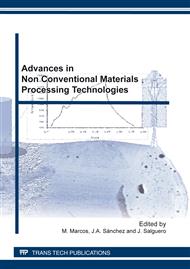p.25
p.31
p.37
p.43
p.49
p.55
p.61
p.67
p.73
Development of a Laser Hardening Simulation Method Including Material Characterization for Rapid Heating Rates
Abstract:
The main disadvantage for industrial application of new processes based on laser surface treatments, such as laser hardening, quenching or precipitation hardening, is the prior experimentation needed to determinate the optimum conditions for processes. The presented work is focused on the development of a tool based on a semi-empirical model to predict accurately the thermal field and thickness of the head affected zone in laser surface treatments in order to avoid the previous experimental setups of this processes. The conventional thermal models are focused on solving the differential equation of temperature field, considering the laser as heat source and thermal properties of each material. However, during the rapid heating treatment processes of metal surfaces are some unknown heat sinks such us metallurgical transformations or a changeable material absortivity that must be taken into account. The model has been adjusted and validated with experimental data for AISI 1045.
Info:
Periodical:
Pages:
49-54
Citation:
Online since:
February 2012
Authors:
Keywords:
Price:
Сopyright:
© 2012 Trans Tech Publications Ltd. All Rights Reserved
Share:
Citation:


